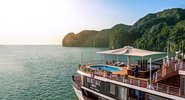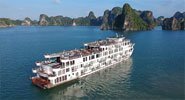Pearl Farm in Halong Bay: The Complete Guide
Pearls are naturally unique ‘gemstones’ produced inside a living creature (Mussels) and have been a symbol of beauty for hundreds of years. Those interested in pearls and how they are acquired are in luck as Ha Long is home to a thriving pearl farm, and it has opened its doors to the public. The pearl farm is located near the Vung Vieng fishing village and is about 24 kilometers (15 miles) from the center of Halong city.

A Bit of History
In 1995, a Japanese-owned pearl farm was established in Halong Bay near Sung Sot Cave. After achieving significant success, the farm transitioned ownership and is currently managed by Halong Pearl Joint Stock Company, a Vietnamese enterprise.
The farm supports a thriving ecosystem for pearl cultivation, with pearls growing year-round. It maintains a core team of 15 permanent staff members and employs a total of 40 individuals from various regions of the country.
Covering an area of 74 acres, the farm comprises approximately 3,000 cages dedicated to pearl oysters. Visitors to the farm can witness the intricate and time-consuming process of pearl growth, harvesting, and extraction. You will discover that cultivating pearls requires substantial patience and a deep understanding of aquaculture.
 Pearl farming during a summer afternoon.
Pearl farming during a summer afternoon.
What Types of Pearls are Cultivated in Halong Bay?
The pearls cultivated in Halong Bay are saltwater pearls, known for their durability and stunning luster. Unlike freshwater pearls, which tend to degrade over time, saltwater pearls can remain radiant for hundreds of years. On average, saltwater pearls have a lifespan of around 100 years, significantly longer compared to about 30 years for their freshwater counterparts.
Pearl farming is a meticulous process influenced by various factors, including water depth, quality, and salinity. When conditions are ideal, it takes approximately five years for a mussel to produce a pearl of marketable quality.
Visitors to the Pearl Farm can gain insight into the pearl cultivation process. The tour includes a view of the floating rafts where the pearls are nurtured, a look at the processing rooms where workers extract pearls from their mussel shells, and finally, a visit to the showroom displaying beautifully polished pearls that conclude the cultivation process.
Pearl Facts:
- In the wild, a pearl can be found in approximately 1 in every 10,000 mussels.
- There are three primary types of saltwater pearls: Tahitian, South Sea, and Akoya.
- South Sea pearls are the rarest and most valuable type of pearl.
- The most renowned pearl in history is called 'La Peregrina,' translating to 'the incomparable' in Spanish. La Peregrina is around 500 years old and is roughly the size of a large egg.
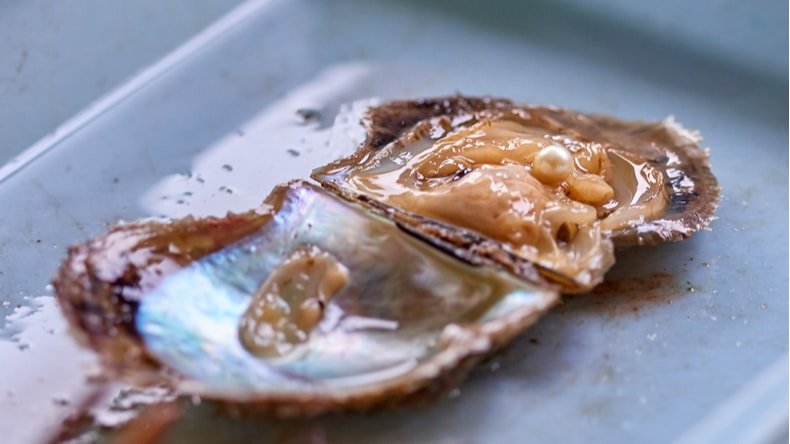 Fresh white pearl (Mussel pearls)
Fresh white pearl (Mussel pearls)
How to Visit and Entrance Fees
A visit to the Halong pearl farm is commonly part of the itinerary for cruises lasting at least three days. As of 2025, entry to the farm remains 30,000 VND (approximately $1.25 USD) per person. If you participate in a cruise package, the entrance fee is typically included in the total cost.
If you prefer to visit the pearl farm independently, the most effective way is to hire a local rowing boat for transportation to and from the Pearl Farm. Make sure you agree on a fare before boarding the boat to avoid any misunderstandings.
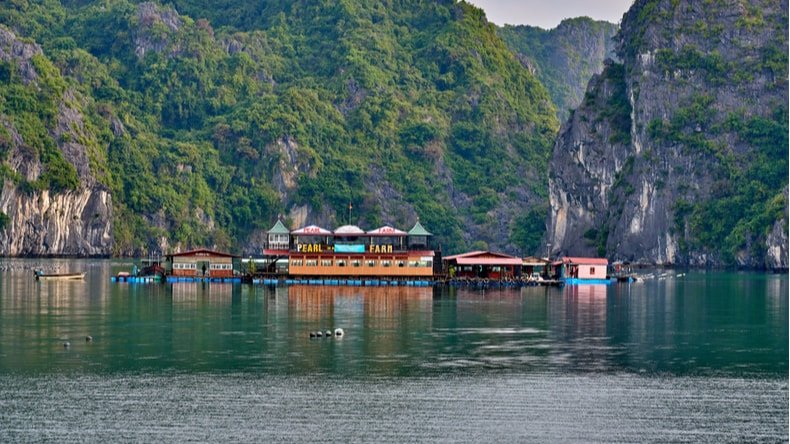 Most cruise tours currently include a stop at one of the floating villages or pearl farms in Halong Bay.
Most cruise tours currently include a stop at one of the floating villages or pearl farms in Halong Bay.
When to Visit
As the farm is located outdoors, visitors should be equipped for variable weather conditions, which can be quite unpredictable in Vietnam. During the summer months from June to September, guests should brace themselves for a hot and humid Southeast Asian summer experience. Conversely, from October to January, the weather tends to be cooler and more temperate. Nevertheless, it's essential to stay informed by checking the weather forecast beforehand. Remember to pack sunscreen and mosquito repellent to ensure a comfortable visit.
Where to Buy Pearls in Halong Bay
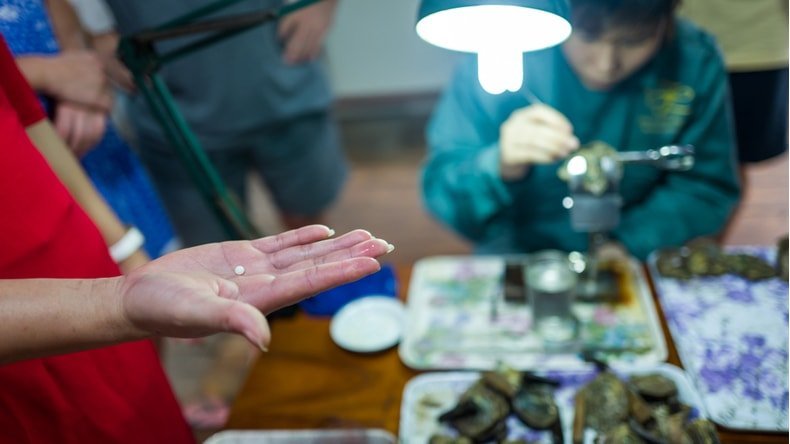
Now that you’ve discovered where and how pearls are cultivated, you may be eager to experience the pearl market for yourself. So where can you purchase these stunning gems? As of 2025, the Halong Pearl Joint Stock Company operates three locations where you can visit a pearl farm and buy beautiful pearl jewelry.
All three locations are officially recognized by the Department of Tourism.
- My Ngoc Tourist Center, Don Dien, Ha Khau Ward, Phone: +84 203 351 1519
- Halong Pearl Farm I, Bo Hon Island, Halong Bay, Phone: +84 203 351 1519
- Halong Pearl Farm II, Vung Vieng, Halong Bay, Phone: +84 203 351 1519
Only within the fishing village do they actively cultivate and harvest pearls. The My Ngoc Center predominantly emphasizes the processing and crafting of pearl products.
At the center, visitors can explore a wide range of pearl products, including necklaces, bracelets, and rings. All types of jewelry are available at My Ngoc, skillfully created by master artisans. The pearls are meticulously crafted into truly stunning and one-of-a-kind pieces.
In addition to purchasing jewelry, guests have the opportunity to learn about the processing of raw pearls and the jewelry manufacturing process. Trained staff guide visitors as they explore and assist them in finding the perfect piece of jewelry to purchase.
According to expert evaluations, Halong pearls are known for their exceptional quality characterized by high purity, thickness, and an array of stunning natural colors including gold, glass, pink, cherry, and gray.
As of 2025, Halong Bay pearl jewelry is still rated five stars. These pearls meet international standards while being approximately 20 to 30% more affordable than similar products in other parts of the world. This pricing appeal continues to attract numerous international tourists to Halong Bay for pearl shopping.


